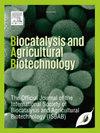从植物资源中提取精油作为强效杀虫剂和驱虫剂:现状与未来展望
IF 3.4
Q2 BIOTECHNOLOGY & APPLIED MICROBIOLOGY
引用次数: 0
摘要
在农作物上大量使用化学农药对人类和昆虫捕食者都是有害的。长期使用会积累有毒残留物,污染水源、土壤和食物链。以植物为基础的精油具有广泛的抗真菌、杀幼虫剂、杀卵剂和杀虫剂活性,目前已成为保护农作物的可持续替代来源。现在有证据表明,精油会改变昆虫的神经和运动活动。它们具有特定的目标,可能会影响害虫的各种系统。与化学虫害相比,精油一般不会或较少对哺乳动物(包括人类)造成伤害,因此可以作为相对更安全的分子来控制破坏性害虫,减少经济损失。与化学杀虫剂相比,它们成本效益高、全年可用、在环境中无持久性,而且对脊椎动物或非靶标的毒性极小。这篇简短的综述重点介绍了香精油作为强效杀虫剂、储藏产品害虫消杀剂、驱虫剂和杀菌剂的现状。这也为设计更优越的策略提出了建议,如采用纳米包囊技术来改善稳定性和防止挥发。本文章由计算机程序翻译,如有差异,请以英文原文为准。
Essential oils from plant resources as potent insecticides and repellents: Current status and future perspectives
The extensive use of chemical pesticides on crop plants is harmful to mankind as well as to insect predators. Their long-term usage contaminates water, soil, and the food chain with the accumulation of toxic residues. Plant-based essential oils with a broad spectrum of antifungal, larvicidal, ovicidal, and pesticidal activities are now being preferred as an alternative and sustainable source to safeguard crop plants. Evidence now exists that essential oils alter the nervous and locomotor activities of insects. They target specific and may affect the various systems of the insect pests. This may generally do no or less harm to mammals including humans when compared to chemical insect pests, therefore they can be deployed as relatively safer molecules to reign in the devastating pests and reduce economic losses. They are cost-effective, available throughout the year, non-persistent in the environment, and vertebrate or non-target toxicity is minimal in comparison with chemical pesticides. This brief review focuses on the current status of essential oils used as potent pesticides, stored-product insect pest reduction, insect repellents, and fungicides. This also suggests the way forward to design superior strategies such as the technique of nano-encapsulation to ameliorate the stability and stave off their volatilization.
求助全文
通过发布文献求助,成功后即可免费获取论文全文。
去求助
来源期刊

Biocatalysis and agricultural biotechnology
Agricultural and Biological Sciences-Agronomy and Crop Science
CiteScore
7.70
自引率
2.50%
发文量
308
审稿时长
48 days
期刊介绍:
Biocatalysis and Agricultural Biotechnology is the official journal of the International Society of Biocatalysis and Agricultural Biotechnology (ISBAB). The journal publishes high quality articles especially in the science and technology of biocatalysis, bioprocesses, agricultural biotechnology, biomedical biotechnology, and, if appropriate, from other related areas of biotechnology. The journal will publish peer-reviewed basic and applied research papers, authoritative reviews, and feature articles. The scope of the journal encompasses the research, industrial, and commercial aspects of biotechnology, including the areas of: biocatalysis; bioprocesses; food and agriculture; genetic engineering; molecular biology; healthcare and pharmaceuticals; biofuels; genomics; nanotechnology; environment and biodiversity; and bioremediation.
 求助内容:
求助内容: 应助结果提醒方式:
应助结果提醒方式:


